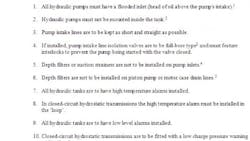How To Prevent Hydraulic Failures Resulting From Ignorance Or Omission
In '6 Costly Mistakes Most Hydraulics Users Make...' available for free download here, I make the point that a checklist is a tool that serves a very important function: to INFORM and REMIND. In so doing, mistakes or omissions resulting from ignorance and/or memory lapse -- and which can easily result in hydraulic components failures -- can be prevented.
On this note, here's an instructive story sent to me by Hydraulics Pro Club member Rich Catalo:
"We deal with a very large dock and dredge company. They have many pieces of hydraulic equipment from different manufacturers. The last call I received was over a tech that removed a hydraulic cylinder that was in need of a reseal. The tech did OK removing the hydraulic cylinder but failed to cap off the hydraulic hoses with the proper plugs.
He stuffed shop towels in the hose ends instead. The hydraulic cylinder was reinstalled and the hydraulic hoses reconnected. But the tech forgot about the shop towels and ran the hydraulic system. The rags eventually got caught in the directional control valve."
This reminds of a similar incident which occurred many years ago. Fitters on a mine-site changing out a main hydraulic pump on an O&K/Terex RH200. Big pump. 1000 L/min at up to 350 bar. And, at the time, worth around $40,000.
You can imagine: dirty mine-site, hydraulic excavator covered in dust, and a 6" diameter inlet hose open to the elements. So one of the fitters stuffs a rag into the pump's inlet hose to keep the dirt out.
Well, you can guess what happened. Rag left in inlet hose. Pump started up. Five minutes later THAT pump is being changed out. Entry into the Guinness Book of Records for the shortest hydraulic pump-life in history.
The obvious lesson here is NEVER stuff anything into a hydraulic hose, tube or pipe. Because if it's not stuffed in, you can't forget to take it out.
But there's a wider issue to consider here. Were the techs involved in these two situations stupid or just human? I say it's the latter. In the heat of the moment they forgot to do (or un-do) something critical. And to forget doesn't make you stupid. It makes you human.
It's akin to a surgical team leaving a sponge or clamp inside a patient's abdominal cavity. It shouldn't happen. But it does. In the techs' case, they were trying to do the right thing: prevent contaminant ingression. Albeit in the wrong way. And absent a written checklist to prompt them to remove the inserted rags, well, they were a bug looking for a windscreen.
On the subject of checklists, there's a book everyone should read. Even if you're not heavily involved in hydraulics. It's called 'The Checklist Manifesto' by Atul Gawande.
Among other things, it's an EYE-OPENING insight into the medical profession generally and surgical procedure specifically. And heaven forbid, should you or a loved one ever need surgery, you WILL thank me for recommending you read this book.
It's fair to say most surgeons aren't stupid. But they are human like everybody else. Which means they forget to do things on occasion. And Gawande, a talented surgeon himself, peels back the curtain as he makes the case for the adoption and use of checklists in medicine and everywhere else.
Seven years BEFORE Gawande wrote his book, I advocated the use of checklists in one of mine. And if you have anything at all to do with hydraulics, 'Insider Secrets to Hydraulics' is another book you should own and read.
The start-up procedure I outline on pages 29 to 33 has 26 steps. And this generic procedure can be easily modified and adapted to a specific machine to prevent the type of component-killing incidents described above.
It's true that you can't fix stupid. But you can and should take ACTION to ensure a memory lapse during your next hydraulic component change-out doesn't win you the dubious title of shortest hydraulic-component service life on record!
About the Author
Brendan Casey Blog
Author
Brendan Casey is a war-weary and battle-scarred veteran of the hydraulics industry. He's the author of The Hydraulic Troubleshooting Handbook, Insider Secrets to Hydraulics, Preventing Hydraulic Failures, The Definitive Guide to Hydraulic Troubleshooting, The Hydraulic Breakdown Prevention Blueprint and co-author of Hydraulics Made Easy and Advanced Hydraulic Control. And when he's not writing about hydraulics or teaching it, Brendan is flat-out helping consulting clients from a diverse range of industries solve their hydraulic problems. To contact him visit his company's Website:
www.HydraulicSupermarket.com

Leaders relevant to this article:
